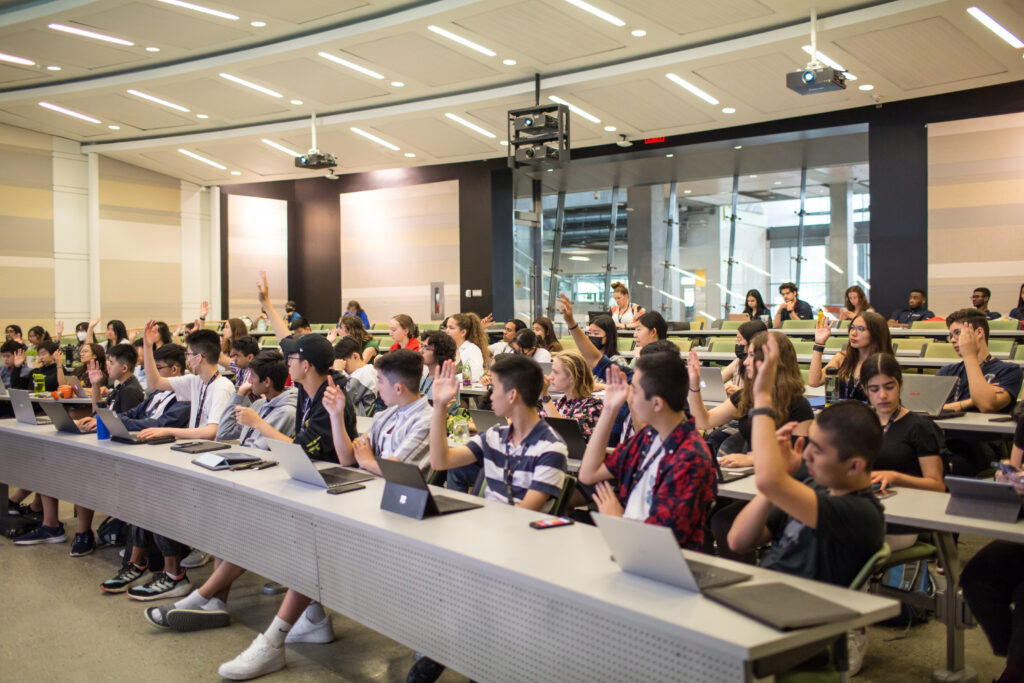Shad is a place where experts and experts-in-training connect. Our long-time partnership with the National Research Council of Canada (NRC) provides an ideal opportunity to introduce participants to this important national science and technology research organization as well as some of the cutting-edge research that their scientists are doing to move research ahead in areas from energy and environment to medical devices to nanotechnology. This year’s Shad program focused on presentations that provided a window into NRC research in health and aerospace.
A sample presentation shows how deep researchers can take the Shads in one session. On Thursday, July 7, Shads at McMaster had the opportunity to deepen their knowledge about a specific area of focus in disease treatment, the role of ion channels in cancer cells. As Donny Xu from Vancouver Island, British Columbia, noted the talk provided a chance to learn about something cutting edge within a field he only knew in general terms. “For me, the talk was super-interesting because I’ve heard about gene therapy to help cancer, but I never got information about it, I just knew it was a thing that exists. It was really cool seeing how it all works and hearing from an expert on it.”

Presenter Umberto Banderali is a Senior Research Officer at the NRC, working in the Electrophysiology team within Human Health Therapeutics. He also holds a PhD in Physics from the Université de Montréal. Using PowerPoint slides with illustrations and images to help demonstrate the complexities of the research, Umberto began by defining ion channels: they’re proteins that are inserted in cellular membranes, vitally important to cell homeostasis among other elements. He also explained the complex patch clamp technique that allows scientists to work with these microscopic elements by inserting a micropipette into a cell.
Importantly, Umberto was careful to explain the why of his research, that scientists have fairly recently defined certain diseases as caused by disfunction of these ion channels, termed “channelopathy” diseases. Besides cancer, these include epilepsy (disrupting the nervous system) and cystic fibrosis (disrupting the respiratory system). Scientists hope that by learning more about these ion channels they can find ways to improve these conditions.
In addition to explaining the problem, Umberto also shared the cutting-edge research going on to better understand the ion channels. Examples included work on Acute Myeloid Leukemia and childhood brain tumours. He also shared the findings that resulted when they performed the same experiments but with inhibitors, which showed promising results.
So why are ion channels so under-explored and under-used if they could be vital to solving important diseases? Umberto asked and answered his own question by noting that because ion channels are everywhere, it’s hard to target one, and when they’re so similar using inhibitors could also affect other healthy tissues inadvertently. Another important area for research is therefore working to identify regions on cells that are unique to the cancer or other disease and developing antibodies that specifically recognize them.

Following all this interesting research, a question period gave the Shads a chance to ask about everything from specific cell elements to how researchers develop antibodies for use in their experiments. Katie Yu from Iqaluit, Nunavut, also wanted to know how Umberto landed his role at the National Research Council, giving him a chance to share a bit more about his workplace which employs 4,000 people at 14 research centres across Canada. “Come and visit us sometime!” he encouraged. After the presentation, Katie shared that hearing from a working scientist was a highlight. “It was interesting to hear from someone who works at a large science organization,” she said.
Asked after the presentation about their experience, other Shads echoed Donny’s enthusiasm about the way Umberto connected the cutting-edge to the familiar. “It was interesting hearing about diseases we know about, like cystic fibrosis and cancer, in the context of something I’ve never heard about like ion channels,” said Simi Akinpelu from Oakville, Ontario. ZiJi Huang from Keswick, Ontario said he found the presentation easy to follow despite the complex subject matter. “I was impressed by the depth of the presentation, such detail but also related to things we already knew like cell division and mitosis. Plus, he put it in a way that we could understand. That was awesome.”